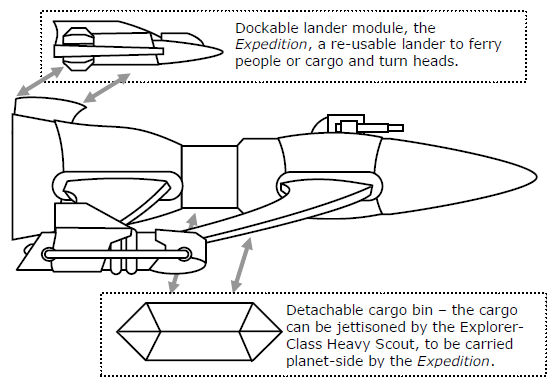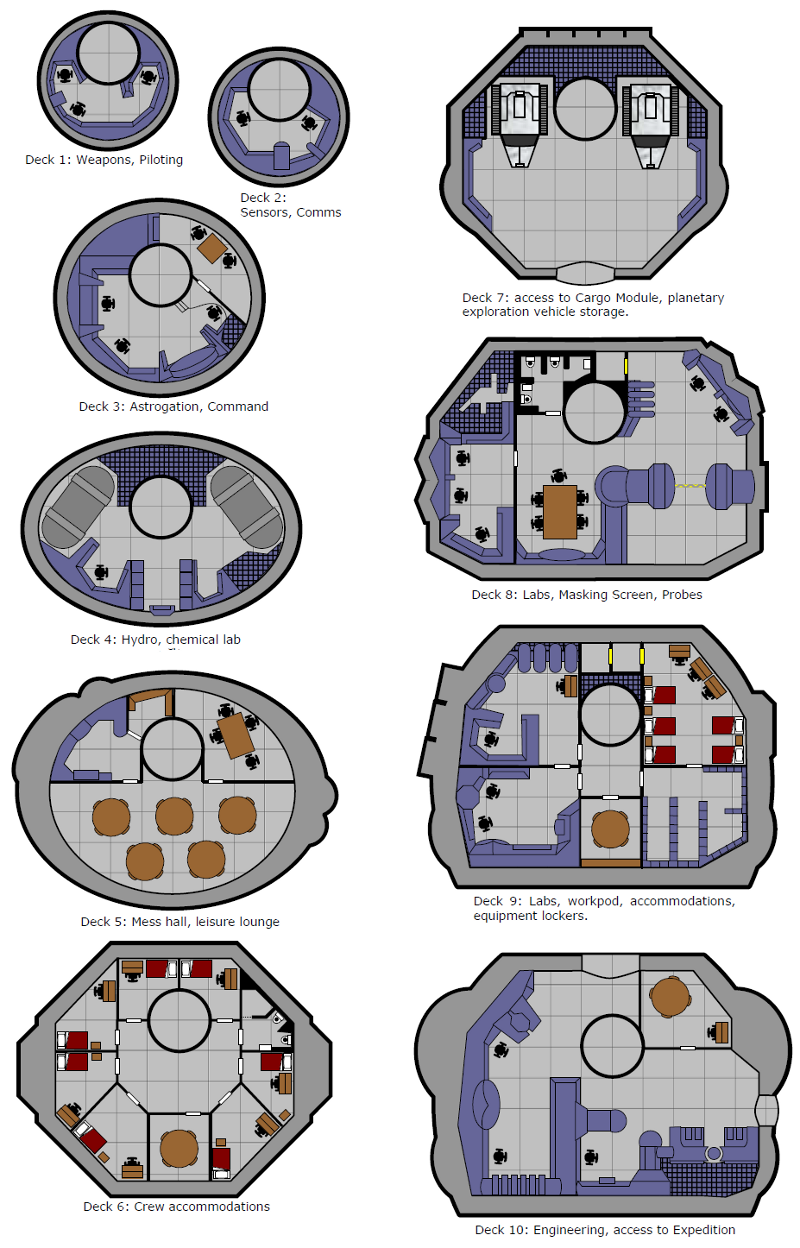Explorer-Class Heavy Scout Craft
By Bill Logan

The civilian sect is ripe with explorers looking to make a name for themselves. Scientists from all walks look for an opportunity to find a new discovery and claim it as their own. Over time, they’ve relied on paying the high costs for modified military vessels dumped by the UPF or cycled out of production by corporate executive orders. The civilian scientific community, tired of getting hand-me-downs not actually created for exploration, are happy to hear the news of the release of the Explorer-Class Heavy Scout.
Design Goals
Designed specifically for private UPF-contracted exploration teams, the Explorer-Class Heavy Scout is
an interstellar-capable starship capable of performing most localized experiments and procedures when
surveying foreign soil, be it asteroid, rogue planet, comet, sun, or world. The ship is basically a hull size 5 long cylinder, roughly 100 meters from bow to stern. It’s twice the size and displacement as the ever-popular Assault Scout, but is nearly as quick and maneuverable thanks to its twin type B Atomic engines (unusual for a civilian craft because of the affordability factor).
Being able to land on a planet is normally a high priority for an exploration vessel. However, being able
to sustain faster-than-light speeds normally requires a vessel too large to enter an atmosphere. This ship is no exception.
However, to allow explorers and scientists to land and carry out their missions, a smaller lander module, nicknamed the Expedition mounts to the top of the ship, mating with it. A valid hull-size 1 ship in its own right, the Expedition serves a multi-faceted role as escape launch, planetary lander, cargo and personnel ferry.
Finally, the ship was designed with exploration missions in mind. Its ten decks include the normal
array of crew accommodations and control decks, but a surprising amount of laboratory space. The outside of the ship includes a decent amount of instrumentationclusters as well. It is a ship designed to seek the unknown and put a name to it.


Since so much of the internal space is taken up with scientific and technological equipment, the cargo hold is located externally in a detachable bin, that can be jettisoned into open space so that the Expedition can detach from the starship and mount to the cargo bin and ferry it to wherever it is needed (between vessels, to dock at a planet’s surface, etc.).
The diagram shown at right highlights the detachable Expedition and Cargo module locations, and the images at show the detachment and cargo carrying features via photographs taken live during maneuvers.
Incentives to Private Groups
The United Planetary Federation wants to encourage private groups to undergo peace-time exploration.
Additionally, corporations like Pan-Galactic Corporation, Streel, and others are similarly interested in neutral third-parties offering up their exploration skills for hire.
Because of this, the Explorer Class Heavy Scout starship is the first of its kind to have its sale subsidized by the UPF and seven mega-corporations, reducing the cost to the consumer. This basically cuts the price to half normal.
Getting Around on Deck
The starship is designed using the standard Knight Hawks perpendicular concept, with the “bottom” deck being at the tail of the craft. The top-most deck (Deck 1) is the smallest, and is located at the nose of the craft. Access to the Expedition is via a hatch on Deck 10, while access to the detachable Cargo Module is on Deck 7.
Hatches have standard airlocks. Internal doors slide into the walls at the push of a button on the door itself. Doors can be locked by typing a code on a key panel on the door, though a master key number is known to the ship’s owner (and can be changed only by him or at a repair center).
Doors marked with a yellow and black border (on the deck plan maps on the following page, they’re shown colored in yellow) are locked by default, and must be unlocked by someone trusted with the security key number.
The deck plans found on page 31 are typical, though individual designs may vary. Squares on the map are 2 meters across.
Elevator. A single elevator shaft runs through the entire length of the ship. It is relatively small in size. Eight human-sized occupants are possible, though this is less a weight limitation as it is a space limitation. The elevator can traverse one deck per 6-second turn. Since the ship has ten decks, the longest one would have to wait for a lift is one minute, assuming the elevator wasn’t being held open at a given floor. The ship’s owner is given a master override that allows him to take control of the elevator, locking out all others, if he needs to.
Crew Cabins. Deck 6 has crew accommodations. Each room varies in size and shape, but all share a few common features: a modest bed, a small personal desk with computer terminal, intercom, and small night stand. They lack portals of any sort, though the conference lounge on this same deck has a single portal to view the planet around which the ship is orbiting.
Deck 9 also has some accommodations, though these are not quite as stately as the crew’s own cabins. This open area lacks personal space, and is typically used to house scientists or technicians hired on (or who booked passage) for specific exploration missions.

Defenses
The ship is not a military one. Its framework and superstructure lack the strength to take much damage, and the number and power of defenses are limited. However, even a civilian ship runs into trouble now and then, so the Explorer Class Heavy Scout vessel is equipped with only to defenses: a laser battery (controlled from Deck 1) and a Masking Screen dispenser (controlled from Deck 8). A Reflective Hull rounds out the defensive power of the craft.
Buy One Today!
Because of the subsidies paid by several megacorporations, the Explorer Class Heavy Scout ship is
quite affordable. With a basic set of science and technical labs, ion drives, and not much in the way of
luxury, the entire package will cost you less than a million Credits.
Contract
When you purchase an Expedition Class Heavy Scout, you can take the option of purchasing it
“under contract.”
Gambling on the intrepid success of private exploration teams, the special interests (private investors, mega-corps, etc.) worked together to set up this special economic aid package.
What’s in it for you
The core ship (not the Expedition) will cost the characters only sixty percent of the price the ship
would normally cost using the Knight Hawks rules.
What’s in it for them
But of course, this isn’t a grant, it’s a binding agreement; there’s something in it for them as well.
For ten years after purchase, forty percent of the value of all findings are given to the investors,
divided up among them according to the percentages they all contributed. The end result: more adventurous private explorers, less expense for the investors. Everyone wins. If the characters bound by the contract don’t make any discoveries or stake any claim over any resource before
the ten year period is over, they become responsible for paying back the forty percent that was paid, with one hundred percent interest.
Contract Buy-Out
Some characters may not like being bound like indentured servants to unknown parties. They might
not enjoy being the pawns of the kings of space. Heck – they may even find one or more of those
megacorporations clashing with them over some of their findings! After all, Streel would love to have 100% of the mining rights on that moon you just discovered! Therefore, there is an option to get out of your contract. All it takes is money… lots and lots of money.
But if you fear this, don’t enter such a contract. Space is a big place full of Credits – find a way to get some, and just buy this wonderful ship full-price!

29-33